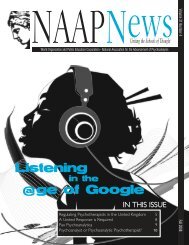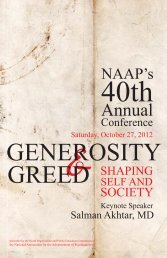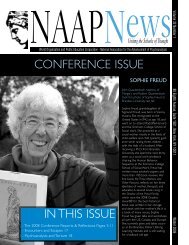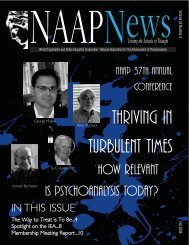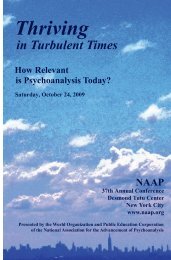Spring 2010 - NAAP
Spring 2010 - NAAP
Spring 2010 - NAAP
You also want an ePaper? Increase the reach of your titles
YUMPU automatically turns print PDFs into web optimized ePapers that Google loves.
INTRODUCING PAMELA ARMSTRONG-MANCHESTER<br />
<strong>NAAP</strong>’S NEW PRESIDENT<br />
Pamela Armstrong-<br />
Manchester<br />
We all take different paths to psychoanalysis.<br />
The Mental Health Association (MHA) set<br />
in motion my career path and psychoanalytic<br />
studies. At 16 I was president of a service<br />
club at Ft. Lauderdale High School in<br />
Florida. Our service: The MHA. I asked the<br />
MHA president, exactly what is mental<br />
health She said, I will do better than tell you<br />
— I will take you to South Florida State<br />
Hospital (SFSH), a state mental hospital.<br />
There I saw people as if from another planet!<br />
I asked myself two questions: How did they get this way How<br />
could they be “cured”<br />
In 1956 occupational therapy (OT) had the most interesting indepth<br />
work with the “mental hospital” population, so I decided to<br />
begin there. I received a BSOT from the University of Florida<br />
(1958-62). My internships were at the Neuropsychiatric Institute,<br />
University of Illinois, Chicago; Massachusetts Mental Health<br />
Center, Boston; Milwaukee Children’s Hospital; and the Delaware<br />
Curative Workshop in Wilmington.<br />
After completing my internships in the fall of 1963, I returned to<br />
Florida to work at SFSH. The OT department director was part<br />
of a self-identified interdisciplinary secret group referred to as<br />
“the underground.” Their goal: to change the state hospital<br />
(which met all standards of accreditation but rarely discharged<br />
anyone) from a hospital of custodial care to a hospital of dynamic<br />
treatment, one which would facilitate the patient’s return to the<br />
community rather than a continual existence within SFSH.<br />
Among other tasks, I innovated two wards, creating in each a<br />
therapeutic community including individual OT, group and activity<br />
group therapy, patient government, and the training of each<br />
ward’s staff, including the unit chief, an M.D. The result: more<br />
people discharged than ever before in the history of the hospital.<br />
I could reduce some severe symptoms, but my two burning questions<br />
were still unanswered.<br />
Eventually I moved to NYC seeking answers. My first job there<br />
was as an occupational therapist on the psychiatric in-patient unit<br />
of the Neurological Institute, at Columbia-Presbyterian Hospital<br />
for one year.<br />
I received a full scholarship for an MA in psychiatric OT. While<br />
my MA degree was from New York University, the academics<br />
were in a combined program between NYU and Columbia<br />
University, with a 12-month internship at the Psychiatric Institute<br />
in New York. My MA paper was “The Contrast and Fate of Two<br />
Innovations,” a socio-organizational study.<br />
After graduation in 1967, I was hired as the OT supervisor at<br />
PHP, Partial Hospitalization Program, New York Medical College,<br />
NYC, where I worked for 10 years. PHP, under the brilliant direction<br />
of Clifford J. Sager, M.D., received an NIMH grant to create a<br />
PHP “that worked.” The training at this amazing and unique program<br />
included many forms of therapy: individual, group, activity<br />
group, family, gestalt, and video therapy, plus psychodrama, and a<br />
10-year staff training group. I took part in all the above training.<br />
For several years I was also director of PHP’s evening program.<br />
From my readings and experiences in Florida, Chicago,<br />
Massachusetts, and New York, I realized the profession that<br />
understood the human condition most profoundly was psychoanalysis.<br />
However, Freud denied the hope of psychoanalysis as a<br />
therapeutic method — to all who were not neurotics. I sought a<br />
psychoanalytic institute which also provided psychoanalytic training<br />
to treat people with severe disorders. From my prior clinical<br />
work, I arrived at five criteria I thought essential to a psychoanalytic<br />
training program that was teaching the treatment of schizophrenia<br />
and other preoedipal conditions.<br />
In 1994 I graduated from the Center for Modern Psychoanalytic<br />
Studies (CMPS), which had met my five training criteria. My Final<br />
Project (i.e., dissertation) was “The Unfolding of the Narcissistic<br />
Transference: a Case Study,” an 18-year longitudinal study.<br />
After leaving PHP, while in psychoanalytic training, I became the<br />
Team Leader (clinical and administrative director of 50 staff, 800-<br />
900 patients), of the Coney Island-Sheepshead Bay Out-patient<br />
Department at South Beach Psychiatric Center (SBPC) in<br />
Brooklyn for 5 years. I left there in 1981 for private practice.<br />
My faculty appointments have included Adjunct Professor, New<br />
York Medical College (1968-73), where I supervised medical residents,<br />
MSW students, and psychology interns; and Adjunct<br />
Assistant Professor at NYU’s OT Department (1968-73), where I<br />
taught activity group therapy, group process, group dynamics, and<br />
an overview of group therapy.<br />
Prior to starting psychoanalytic training I attended a public meeting<br />
of the Joint Council for Mental Health. Later, I became the<br />
Joint Council’s secretary. I have served on <strong>NAAP</strong>’s Board of<br />
Trustees for about 10 years and on the Executive Committee for<br />
about 6 years.<br />
It has been my observation from working in all aspects of the<br />
mental health field (in-patient: acute, intermediate, and long term;<br />
out-patient: partial hospitalization and clinic settings; and private<br />
practice) that psychoanalysis is indeed a separate profession. One<br />
application of psychoanalysis, as a therapeutic method, provides<br />
an unparalleled understanding of the human being for candidates<br />
training as psychoanalysts in psychoanalytic institutes. But how can<br />
one mental health profession, namely psychoanalysis, be considered<br />
a subspecialty, as some claim, of three other separate and<br />
different mental health professions To do so contains, constrains,<br />
SPRING <strong>2010</strong> PAGE 3



